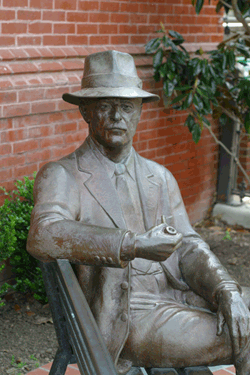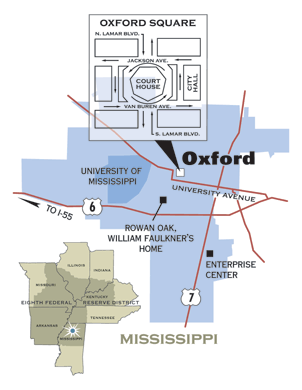Community Profile: Doing It By The Book—Oxford, Miss., Capitalizes on Its Literary Past and Present

As Abraham Lincoln is to Springfield, Ill., as Mark Twain is to Hannibal, Mo., William Faulkner is to Oxford, Miss.
The man some call America's greatest novelist closely identified himself and several of his most famous works with his "postage stamp of native soil." More than four decades after his death, Oxford continues to repay Faulkner for his admiration and loyalty by embracing him and, in a sense, defining itself by his legacy.
About 20,000 visitors each year stroll through Rowan Oak, the estate of Faulkner. Last year, the 161-year-old home reopened to the public following a two-year, $1.3 million renovation. It's estimated that 80 percent of visitors to Rowan Oak come from out of town and spend about $1.6 million here annually.
For Oxford, the renovation is "another arrow in our quiver," says one local official.
"It's unusual for a writer of Faulkner's caliber to live in his hometown and also to write about it," says Bill Griffith, curator of Rowan Oak, where Faulkner wrote some of his most heralded novels, including As I Lay Dying and Absalom, Absalom!
Thanks to its solid literary foundation, the presence of the University of Mississippi (a.k.a. Ole Miss) and a thriving, well-preserved town square, Oxford attracts visitors and new residents. They are not only chasing intellectual pursuits but are looking for a place that embodies Old South nostalgia. Their interest in Oxford has resulted in a 72-percent jump in assessed property values in all of Lafayette County since 1999, according to the local economic development foundation. That's the highest increase in the state.
Keeping It Low Key
It's a little ironic, Griffith admits, that Faulkner's home draws so many visitors. "One thing Faulkner treasured more than anything was his privacy," Griffith says. "I don't think he'd approve of us opening up his house, showing people around and telling stories. However, we keep it as low key as we can. We do not sell anything, and we never will sell anything here at his house."
Out of respect for the man who, according to legend, dug potholes in his driveway to keep away gawkers, no road signs direct people to Rowan Oak, which is nestled off a winding side road just southeast of the Ole Miss main campus. The university bought the estate from Faulkner's daughter in 1973. With the renovation complete, Griffith can turn more of his attention to raising money for a Faulkner museum, which would be housed in a new $12 million expansion of the school's museum complex.
Not far from Rowan Oak's serenity is the town square-the hub of Oxford's sound and fury. Around the historic courthouse are coffee shops, eclectic restaurants, an art gallery, an old-fashioned department store, specialty boutiques and a bookstore called Square Books, which was instrumental in the square's renaissance when Richard Howorth opened it 25 years ago.
Howorth still owns Square Books today, but spends most of his time on his other job-mayor of Oxford. He leaves the day-to-day operations of the business to general manager Lyn Roberts.
"Richard was really the first person to take one of the buildings in the square and renovate it," explains Roberts. "He added some vibrancy to the area. I don't think Square Books can take 100 percent of the credit, but it has helped make the square a destination for people."
Recently, the bookstore opened two spinoffs in the square: Square Books Jr., selling children's books, and Off Square Books, which sells discounted books. The latter is where the company hosts most of its 150 events each year, including numerous book signings. Ole Miss Law School graduate John Grisham, who owns a home in Oxford, appears at Square Books when he releases a new book.
Because of the square's success, a sort of economic "man bites dog" story has emerged here. The Oxford Mall, which opened on the west side of town in the early 1980s, now sits mostly vacant. Malls and big box stores have wounded most main streets, but the square remains king in Oxford.
"The square is what drives it all," says Hugh Stump, executive director of the Oxford Convention and Visitors Bureau. "You'd be hard-pressed to find 10 towns in the country that have as bustling a square for the size of the town."
And no incentives from taxpayers were ever offered to attract businesses to the square, according to the economic development foundation.
The mall isn't without hope, however. On one side, a movie theater complex is under construction; it will connect to the few stores that remain. The other side of the property has been bought by the university, which plans to base its Innovation and Outreach Center there.
The state's flagship university, Ole Miss has a weighty presence in Oxford. It's not only the largest employer, but its student population is about equal to the number of permanent residents in the city. Besides the mall project, the university is planning other major construction: a new law school building and an expansion of the journalism department.
Graduation isn't the end of some students' involvement with Oxford. Well-to-do Ole Miss alumni are buying houses or condos here, even though they aren't full-time residents. As a result, home prices are jumping. Homes close to the square go on the market for as high as $400,000. This is forcing full-time residents to move to outlying parts of the county to find affordable real estate. One telling statistic is that only one of Oxford's nearly 60 police officers lives within the city limits.
"That shows the disparity in the real estate market when people who provide city services can't even live in the city," Stump says.
Adds Max Hipp, executive director of the Oxford-Lafayette County Economic Development Foundation: "Affordable housing is a problem. It's very hard for a young couple to start out and make a go of it inside the city limits. Homes are very expensive."
It's a big-town side effect that is challenging this small town community. Roberts calls Oxford a "crossroads" community: "It is still a small town, but because of the university and what our store offers, people have access to a lot of things that are cosmopolitan."

Oxford, Miss.
| BY THE NUMBERS | ||
|---|---|---|
| Population | ||
| Oxford: | 12,761 (2003) | |
| Lafayette County: | 40,745 (2004) | |
| Labor Force | ||
| Lafayette County: | 19,940 (Feb. 2005) | |
| Unemployment Rate | ||
| Lafayette County: | 4.8 (Feb. 2005) | |
| Per Capita Personal Income | ||
| Lafayette County: | $23,927 (2003) | |
| Top Five Employers | ||
| University of Mississippi | 2,500 | |
| North Mississippi Regional Center | 1,100 | |
| Baptist Memorial Hospital | 2,000 | |
| Whirlpool Corp. | 509 | |
| City of Oxford | 264 | |
Views expressed in Regional Economist are not necessarily those of the St. Louis Fed or Federal Reserve System.
For the latest insights from our economists and other St. Louis Fed experts, visit On the Economy and subscribe.
Email Us

